Resource Planning and Allocation in Software Development Projects
Effective management, planning, and resource allocation can drastically influence your project’s flow. Learn about how to organize and manage your company’s resources and discover how resource management should work in IT companies that you consider working with.
The times when a groundbreaking product could be developed by a small team in a garage are long gone. Now, software development requires teams of multiple specialists to work in sync, sometimes on multiple projects at the same time. As a result, demand has increased for effective management.
Resource planning relies heavily on accurate estimation of the time and budget at the start of the project and the prioritization skills of a project manager.
If a team handles multiple projects, the management aspect becomes even more challenging. How do you juggle all of your specialists and remember which projects they work on? How will it affect the project if a specialist goes on vacation or sick leave? How do you allocate skills, time, and equipment?
I’ll answer all of these questions in this article. You’ll learn how to incorporate planning in your own company or integrate your own processes into those of your software development partner.
What is resource management in software engineering?
Resource management is a set of practices that help accurately allocate materials and people during the planning stage of development.
IT resource management can also be utilized each time the team changes: for example, if you add more team members. Planning allows a software development company to ensure that it adheres to the client’s deadline, requirements, and budget.
Without proper planning, you can experience negative consequences, such as:
- Missed deadlines
- Delays in development
- Poor quality work
- Overbudgeting
- Security issues
- Waste of money and efforts
- Poor team engagement
Resource planning relies heavily on accurate estimation of the time and budget at the start of the project and the prioritization skills of a project manager. There are varying approaches to resource management in an IT company depending on the project and the industry. In this article, you’ll learn about managing resources particularly in software development.
What are resources in software development?
In software development, resources are anything a team needs to build a software product within the set budget and time limits.
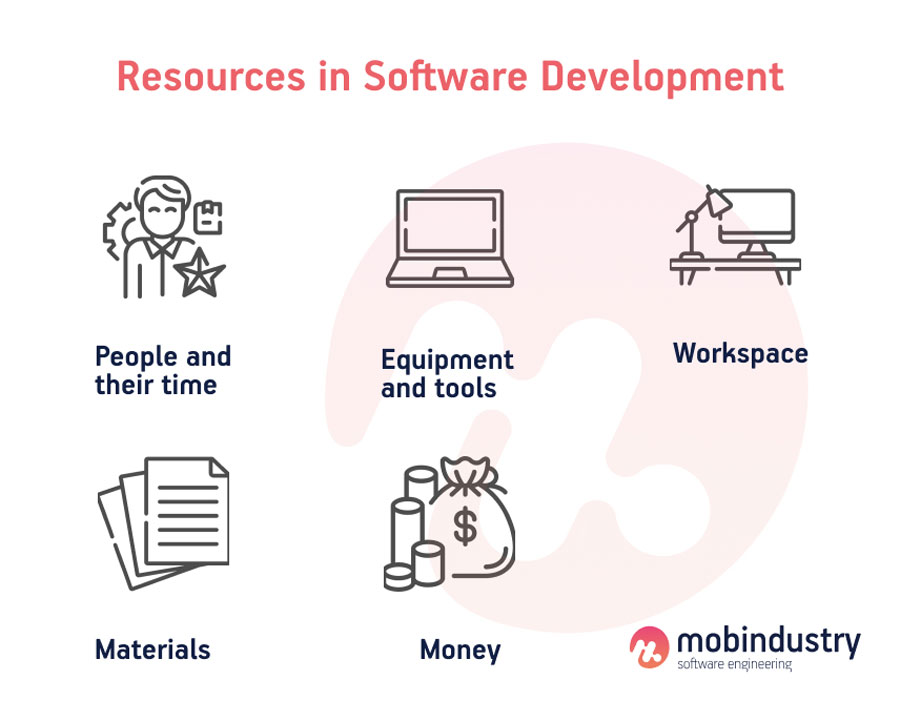
Usually people think of skills, specialists, and time as resources, but these aren’t the only types of resources in software project management. Let’s review them all.
People are the most expensive yet valuable resource. Your team members contribute not only their time but also the skills they’ve been working on for years. When working with people, you need to take human factors into account: your team member could leave the company, go on sick leave, or take time off for any other life circumstance. There are many tools for human resource management in a software project.
Equipment and tools include everything you need to pay for, from a desk and a laptop to software tools.
A workspace is usually an office or a coworking space. With the COVID-19 pandemic, more and more people started working from home, and many companies now offer compensation packages that include home expenses for their employees.
Materials include office supplies and even means of transport to get to a client.
Money is needed to pay for every resource mentioned above.
Top resource metrics
Let’s talk about how to measure resources needed in software development projects. This will help you accurately calculate everything you have at hand and distribute them among your projects.
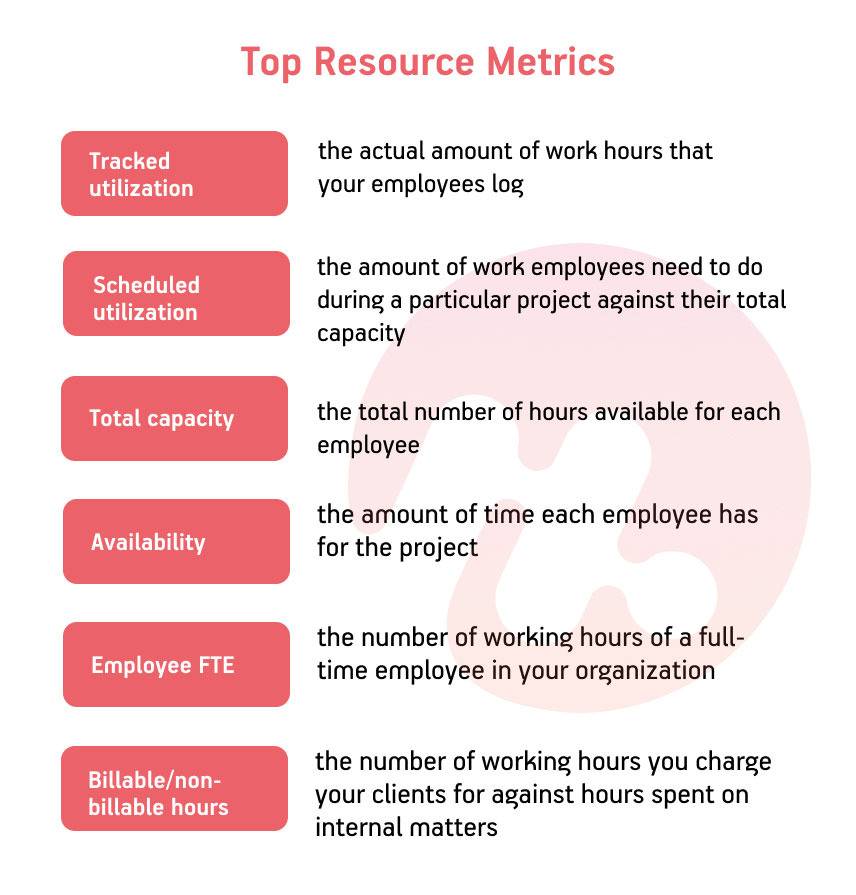
Scheduled utilization is the amount of work employees need to do during a particular project against their total capacity.
Tracked utilization is the actual amount of work hours that your employees log.
Total capacity is the total number of hours available for each employee. To estimate this correctly, you need to consider all public holidays, sick leaves, and vacation days for each employee.
Availability is the amount of time each employee has for the project. This means the total capacity minus the hours your employee spends on other projects.
Employee FTE (full-time equivalent employee) is the number of working hours of a full-time employee in your organization.
Billable/non-billable hours is the number of working hours you charge your clients for against hours spent on internal matters.
Now that you have a better understanding of what software development resource planning is, let’s talk about the benefits of implementing it correctly.
Benefits of smart resource planning
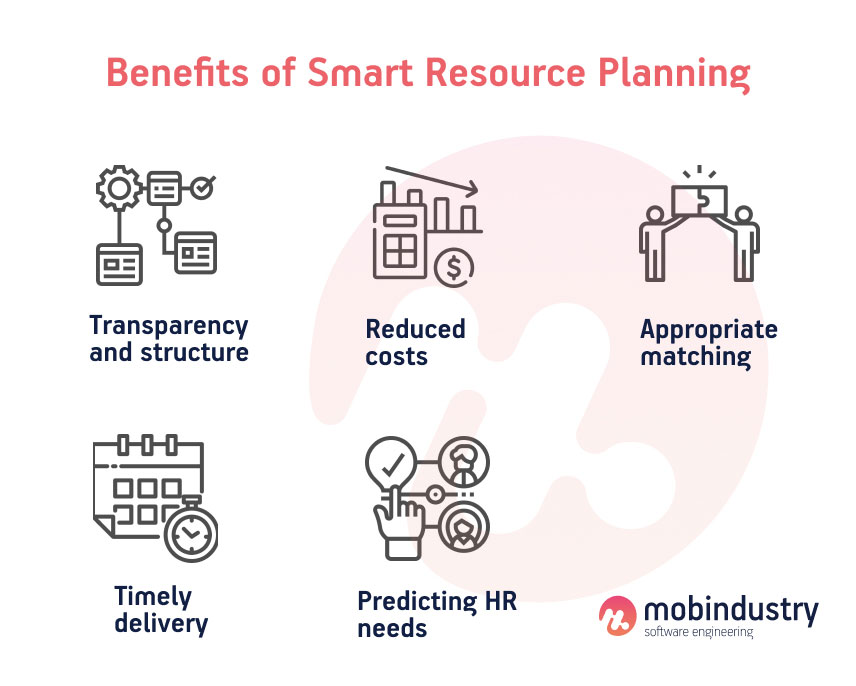
Transparency and structure
Resource planning in software project management increases transparency in each department. Let me give you an example. A salesperson has a new project coming in and needs the help of a developer to give the client a rough estimate. If the planning was done correctly, the salesperson will know exactly which developer to contact by checking who has available non-billable hours.
Reduced costs
One of the main principles of resource allocation in software project management is assigning the most appropriate resource for the given situation. Appropriate assignments show that you realize the potential of a particular specialist or tool and will increase efficiency, which allows you to save money and increase your margins.
Appropriate matching
When allocating developers to different projects, you should consider not only their time and availability, but also their skills and unique experiences. This allows you to get the most out of your employees and increase project efficiency.
Allocating tasks to your team members according to their expertise will promotel give you a highly motivated and productive team.
Timely delivery
Resource allocation and scheduling in software project management allows you to deliver projects that adhere to the initially discussed timeline and budget. s. Because you have assigned the right people for the right tasks, you avoid most technical risks.
Allocating underqualified developers is just as bad as hiring an overqualified team: the first may harm the timeline, while the second can cause overbudgeting.
Predicting HR needs
When you plan your development process, you are able to identify when a certain part of your team starts to run out of available resources, allowing you to hire specialists before your resources are completely exhausted.
Main resource management challenges
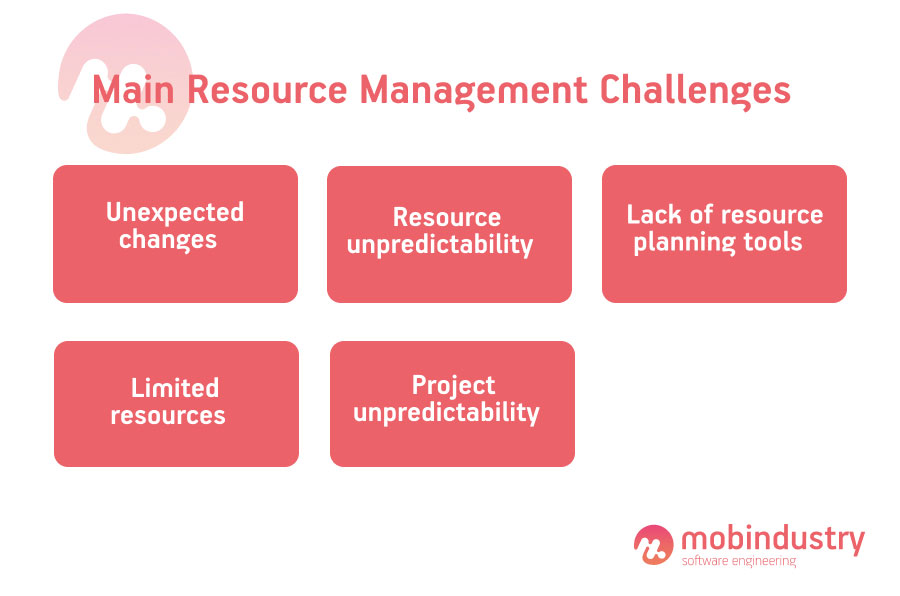
Unexpected changes
In Agile development, changes are inevitable. Business and market changes are reflected in the software. When scheduling resources in software project management, you need to take potential changes into account and keep your team flexible enough to allocate their resources into sprints without harming the overall development process.
Resource unpredictability
Resources themselves are far from being 100% reliable and available. This is especially true for talents: your team members could decide to leave the company or take time off.
Tools are also quite unpredictable. You may find that some tools are no longer enough to sustain the development process and need to be changed.
Lack of resource planning tools
Resource scheduling in software project management can be rather complicated, especially in large projects. Keeping all your planning in Excel spreadsheets can lead to chaos even if your team is small. You’ll need to invest in high-quality project management software tools that will suit your internal business needs and processes. Finding an off-the-shelf tool that will cover all your resource planning activities is quite a challenge.
Limited resources
No matter how big or small your company is, there will always be a limit. To minimize risks and allocate limited resources effectively, you need to ensure your HR specialists have access to data about your current resource needs so they can plan for vacancies in advance.
Project unpredictability
Dozens of issues that can occur during software development, and while it’s impossible to predict them all, it’s certainly possible to calculate and minimize the risks during the planning stage.
Now that we’ve discussed all the benefits and challenges of resource planning and allocation in software development, let’s talk about how to implement resource planning in your business processes step by step.
How to plan and allocate resources in software development
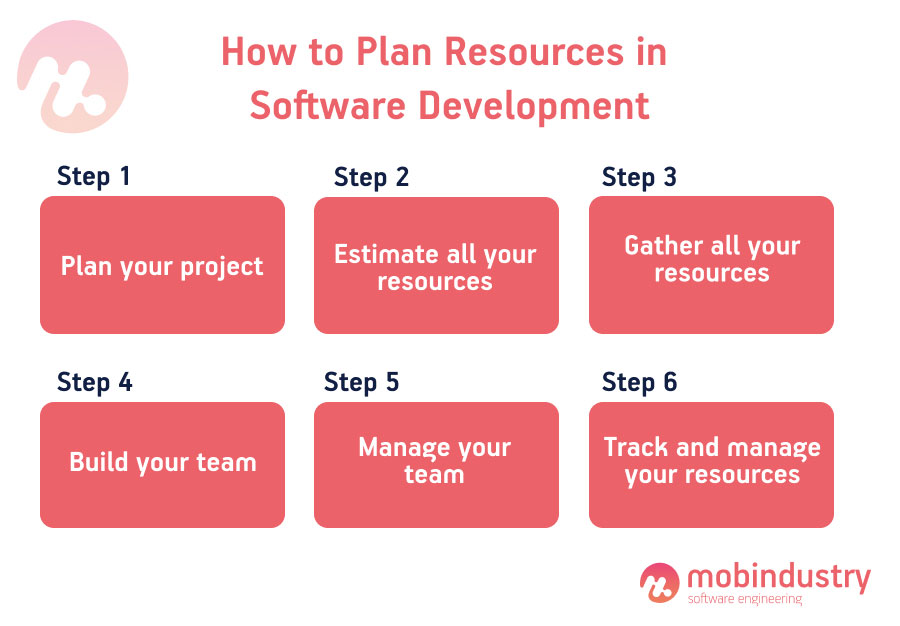
Step 1. Plan your project
The planning stage in software development is the most important, as it sets the project up for success if done correctly. At Mobindustry, we call this a discovery phase, where you learn about business requirements, market conditions, competitors, and user needs before creating a clear technical specification.
Without this planning process, it is difficult to know how many resources you’ll need. The planning process provides a foundation to properly find and distribute resources.
For example, if you plan to build a mobile app for your business and you already have a web development team, your next step is finding a mobile developer. Your resource planning will help you decide where you want to get (and can get) your mobile developers from: either by hiring in-house, hiring freelancers, or partnering with a software development company.
When clients come to us for software development, we first go through a discovery phase, then create a technical specification, and finally prioritize and create a clear roadmap of the whole development process. This also includes a project management plan that accounts for not only developers’ time but also risks, assets, project costs, time for communication, and any other information necessary for project completion.
Our specialists can also help to develop a brand book and design a logo, as well as provide recommendations for the architecture, tech stack and frameworks for your project.
Step 2. Estimate all your resources
Though the Agile process may correct initial plans and estimates, it’s still possible to estimate your resources fairly accurately. Calculate how many team members you’ll need for the project. A typical software development project usually requires at least four the six members:
- Web developer
- Mobile developer (or frontend developer)
- Quality assurance specialist
- Project manager
- Business analyst
- UI/UX designer
The number of specialists can vary depending on your needs. For example, if you need a mobile app for both Android and iOS and you use native technologies, you’ll need two mobile developers with different skills.
Apart from the cost of hiring talent, you also need to calculate the cost of equipment, supplies, workspaces, and any other resources.
Step 3. Gather all your resources
Now it’s time to get everything you need for your project: hire people you need, purchase supplies, rent an office space, and so on. There are multiple ways to acquire resources, and your goal is to choose the most effective way to do so.
Consider these factors when gathering your resources:
- Availability — check if the resource is available at all times
- Cost — check if it’s within your budget
- Ability — check if your resource is enough for your needs
Here are some other specific criteria to look for in team resources:
- Experience
- Knowledge
- Skills
- Communication
- Location/time zone
Step 4. Build your team
After you figure out your talent needs, it’s time to build your team. This may involve training, establishing communication, assigning roles and responsibilities, and setting the rules and procedures for effective communication and teamwork.
It’s important that everyone on the team knows exactly what they and their team members are doing and whom to go to for resolving certain issues.
If you work with an external development team, it’s vital that you have a representative and a person responsible for the whole development process from your side.
Step 5. Manage your team
After your team is formed and starts working on a project, it’s important to set up metrics and track their progress and performance. Issues will inevitably arise during development, so you need to resolve them, provide team members with feedback, and communicate any changes or needs to stakeholders.
Project managers use tools like Jira to track work hours and then create performance reports that include risk summaries, earned value, and forecasts. Managers are also responsible for communicating with stakeholders and prioritizing tasks according to business needs.
Step 6. Track and manage your resources
After you get everything up and running, you need to sustain it. Make sure that resources are still available, compare their actual usage against your predictions, and address any issues that arise.
It’s important to measure resource usage to find blockers or bottlenecks that prevent the development process from advancing efficiently. You need to also attend to your team to prevent burnout or constant overtime.
How we plan resources at Mobindustry
At Mobindustry, resource allocation is especially important because our developers and other specialists often work on several projects simultaneously. We make sure to use the best practices of resource allocation in software project management at our company.
To properly allocate team members to certain tasks and projects, we first look closely at our clients’ needs. After performing competitor analysis and market research, we extract the requirements and turn them into a series of documents that include:
- Technical documentation
- Testing documentation
- A statement of work
After we know what scope of work we have, our project managers prioritize the features and divide the project into sprints. Developers are allocated to the project based on their skills, previous experience, and availability.
We always analyze the market trends and our own internal work to find out what specialists we need to hire to satisfy our clients’ needs.
For project planning we mostly use Jira, as it has advanced reporting capabilities, shows billable and non-billable hours of each developer and specialist, and also helps to track their performance and velocity.
Final thoughts
Resource planning is an important aspect of software development. Creating software is a costly and time consuming process, and it’s so nuanced that it can become very easy to go over budget, make wrong decisions, exceed the desired timeline, or encounter other issues.
The principal goal of any business is to be profitable, so business owners should focus on where they put their money and efforts. This is where resource planning comes into play.
Creating software is so nuanced that it’s very easy to go over budget, make wrong decisions and exceed the desired timeline
To plan resources correctly at the initial stage of the project, you need to have a clear project plan. This involves a technical specification that determines the number of team members, supplies, and third-party tools and integrations that will make up your budget.
If you have any questions about effective resource planning and allocation, or if you’d like to get a quote for your project, make sure to contact us. We can organize the full-cycle development process for you or provide you with specialists to join your existing team.
Frequently Asked Questions
These are the most common consequences of lack of resource planning in a software development project:
- Missed deadlines
- Delays in development
- Poor quality work
- Overbudgeting
- Security issues
- Waste of money and efforts
- Poor team engagement
Here are the common steps of resource planning activity:
- Plan your project
- Estimate all your resources
- Gather all your resources
- Build your team
- Manage your team
- Track and manage your resources
- Scheduled utilization is the amount of work employees need to do during a particular project against their total capacity.
- Tracked utilization is the actual amount of work hours that your employees log.
- Total capacity is the total number of hours available for each employee. To estimate this correctly, you need to consider all public holidays, sick leaves, and vacation days for each employee.
- Availability is the amount of time each employee has for the project. This means the total capacity minus the hours your employee spends on other projects.
- Employee FTE (full-time equivalent employee) is the number of working hours of a full-time employee in your organization.
- Billable/non-billable hours is the number of working hours you charge your clients for against hours spent on internal matters.

